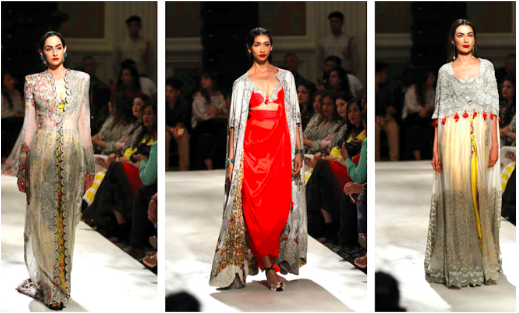Festive Period Fashion: Eastern Wear Pakistan Styles for every single Event
Festive Period Fashion: Eastern Wear Pakistan Styles for every single Event
Blog Article
Revealing the Rich Heritage of Eastern Fashion
Discovering the elaborate tapestry of Eastern fashion introduces a globe where tradition fulfills technology, and craftsmanship intertwines with cultural meaning. From the extravagant silks of old empires to the complex embroidery of nomadic people, each garment tells a tale that transcends time and borders, resembling the rich heritage and creative tradition of the East. As we peel back the layers of background and tradition, an interesting journey waits for, unraveling the keys behind the fascinating attraction and enduring impact of Eastern style on the worldwide phase.
Origin of Eastern Fashion

In Mesopotamia, for example, the Sumerians and Babylonians produced garments utilizing leather, bed linen, and wool, decorated with detailed patterns and precious jewelry. Ancient Egyptians are renowned for their sophisticated weaving skills and the use of lightweight, breathable materials like linen. Chinese fashion emphasized the relevance of shade symbolism and complex embroidery strategies, while Indian garments featured dynamic hues, elegant fabrics like silk and cotton, and elaborate drape styles such as the saree.
These ancient people not only affected each other however also paved the way for the varied and culturally rich tapestry that is contemporary Eastern fashion. With centuries of development, Eastern style remains to prosper, mixing tradition with modern-day impacts to produce special and timeless styles.
Social Impacts and Customs
Attracting from centuries-old custom-mades and beliefs, cultural influences and practices play a crucial function fit the significance of Eastern style (eastern wear pakistan). The rich tapestry of cultures throughout Eastern regions such as Asia, the Middle East, and Africa has heavily affected the clothes styles, colors, textiles, and designs that prevail in Eastern style today
In countries like India, Japan, and China, standard garments like robes, cheongsams, and sarees continue to hold considerable cultural importance and are usually embellished with elaborate embroidery or symbolic patterns that mirror ingrained beliefs and worths. In Center Eastern nations, the moving kaftans and abayas used by guys and ladies not only serve as moderate clothing but additionally mirror the region's social heritage and Islamic practices.
Moreover, using specific colors like red for excellent luck in Chinese culture or complex geometric patterns motivated by Islamic architecture better exhibit just how cultural impacts show up in Eastern style - eastern wear pakistan. By honoring and protecting these social impacts and practices, Eastern fashion proceeds to evolve while staying true to its rich heritage
Development of Eastern Apparel
In time, Eastern garments have actually undergone substantial improvements, mirroring a blend of custom and modernity in their layout and style. Standard Eastern garments such as the saree, hanbok, robe, and salwar kameez have advanced to incorporate contemporary aspects while maintaining their social essence.
One remarkable evolution is using ingenious fabrics and strategies in Eastern garment construction. Conventional handwoven textiles like silk and cotton have actually been complemented with modern materials such as polyester and blends, supplying enhanced resilience and simplicity of care. Furthermore, innovations in printing technologies have enabled elaborate patterns and layouts to be integrated into Eastern garments with precision and detail.
Furthermore, modifications in silhouette and tailoring have modernized Eastern outfit, making them much more appropriate and versatile for diverse occasions. Traditional gown codes have kicked back, enabling trial and error with decorations, designs, and colors. This evolution has not only made Eastern garments extra news enticing and obtainable to a worldwide audience but has additionally guaranteed their continued importance in contemporary style landscapes.
Symbolism in Eastern Outfit
Discovering the deep-rooted social relevance woven right into Eastern clothing reveals a rich tapestry of importance and practice. Eastern garments are often imbued with symbols that show the wearer's social status, spiritual beliefs, and social identity.
In addition, particular garments hold symbolic definitions. Its design, textile, and even the means it is worn all bring deep cultural relevance.

Effect of Eastern Style Today

The consolidation of Eastern elements in Western fashion has actually resulted in a combination of designs that accommodate diverse tastes and preferences (eastern wear pakistan). Designers usually draw ideas from Eastern patterns, silhouettes, and fabrics, developing cutting-edge and distinct pieces that blend traditional and contemporary looks. This cross-cultural exchange has not just renewed the garment industry however additionally promoted a much deeper admiration for Eastern heritage and workmanship
Additionally, the surge of social media and electronic platforms has even more intensified the influence of Eastern style, permitting brand names and designers to reach a larger audience and showcase their cultural heritage to the world. Via cooperations, fashion programs, and on the internet campaigns, Eastern fashion proceeds to thrive and evolve in today's dynamic and interconnected worldwide landscape.
Verdict
To conclude, the abundant heritage of Eastern fashion is a testimony to the social influences, detailed craftsmanship, and extensive significance installed in each garment. From old people to contemporary interpretations, Eastern fashion remains to captivate with its unique blend of practice and innovation. The effect of Eastern style today serves as a reminder of the ageless beauty and creative expression that have made it a global phenomenon celebrated for its abundant cultural heritage.
Discovering the complex tapestry of Eastern fashion introduces a world where tradition satisfies innovation, and workmanship intertwines with social symbolism.The withstanding importance and social importance installed in Eastern clothes proceed to shape and influence the modern influence of Eastern fashion today. Eastern style has actually gone beyond borders, becoming an international sensation embraced by designers, stars, and style fanatics worldwide.In final thought, the rich heritage of Eastern style is a testament to the social impacts, find detailed workmanship, and profound importance embedded in each garment. The impact of Eastern style today serves as a suggestion of the timeless elegance and artistic expression that have actually made it an international sensation celebrated for its rich social heritage.
Report this page